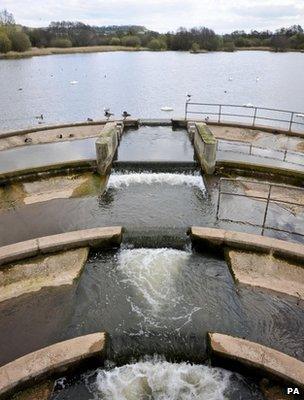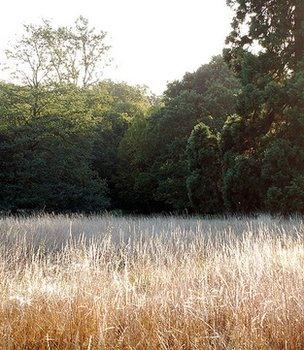What is a drought and what are the consequences?
- Published
Drought conditions now officially extend across all but the most northerly and westerly counties of England.
Data show that some areas have received less than 60% of the average seasonal rainfall, and about 20 million customers in southern and eastern regions are already subject to a hosepipe ban.
The Environment Agency has warned that some areas could remain in drought until at least Christmas, but is there a scientific definition of what constitutes a drought? And what impact could continued reduced rainfall have on wildlife and habitats?
What is a drought?
There is no one-size-fits-all definition of what constitutes a drought.

Experts consider a number of factors before saying an area is experiencing drought conditions
Probably the most widely recognised concept is a meteorological drought, which essentially refers to a period of time without rain, or below the seasonal average rainfall.
Another drought is a hydrological one, which refers to a reduced flow of water in rivers and an area's water table not being replenished as quickly as it is being used.
If you are a farmer, then your main worry is an agricultural drought. This is when there is shortage in the volume of water available to water crops.
The Environment Agency says that the decision to declare a drought in a particular area is "an expert judgement" based on a number of factors.
These include: meteorological - shortage of rainfall and evaporation; hydrological - reduced river flows, low groundwater levels; environmental - dry soils, stress on habitats and wildlife; agricultural - dry soils, need for irrigation, stress on growing plants; and public supply - low reservoir storage, high demands and need for customer appeals and restrictions, drought permits and orders.
When is an area deemed to be a drought zone?
Again, it is difficult to define, because farmers' relatively small storage reservoirs could be vulnerable to just a few months of below-average rainfall, triggering an agricultural drought scenario.
However, a large reservoir that provides water to urban areas is able to cope with short-term shortages but is vulnerable to extended periods of reduced rainfall, particularly during winter months.
Within some slow-responding aquifers, groundwater levels will reflect rainfall patterns over several successive winters. While this may mean there is some resilience within the area's water supplies, a long-term reduction in rainfall levels could leave the aquifers struggling to recover.
How bad will this year's drought will be?
With the above in mind, a drought's characteristics and consequences will be dependent on rainfall patterns and a region's geology and hydrological profile. As before, there is no one-size-fits-all.

High summer temperatures are not necessarily needed for a drought to be declared
In 1997, for example, severe groundwater droughts continued in some areas despite above-average rainfall.
On the other hand, southern England maintained a "healthy water resources outlook" although the region had experienced spring and summer rainfall deficiencies.
In its final phase, the extreme drought of 1975-76 exhibited substantial impacts not only on water supplies but across a broad range of the country's economic, social and leisure activities.
Most people do associate droughts with high summer temperatures.
This does exacerbate the below-average rainfall because it increases the rate of evaporation from the soil, reducing the moisture available to plants and animals.
Whether the summer of 2012 sees above-average summer temperatures remains to be seen.
Why are southern and eastern areas traditionally first to be classified as drought zone?
High population, high agricultural demand and growing urbanisation are major contributing factors.
The Environment Agency says that in southeast England, many of the water resources are already fully committed to existing abstraction licences (abstraction licences are given to businesses, farmers and water companies to take water from rivers and groundwaters).
"So further growth has to be met in a variety of different ways, including managing demands better (retrofitting water efficiency measures in existing housing for example), sharing existing developed sources and, where appropriate, developing new transfers (so water companies sharing and transferring supplies between themselves)," a spokeswoman explained.
Are droughts likely to become more frequent according to climate change projections?
"In the future, climate change and population growth will increase the pressure on water availability," an Environment Agency spokeswoman told BBC News.
"Current climate change projections for the UK suggest that by the 2050s, under the medium emissions scenario, summer temperatures may increase and summer rainfall may decrease.
"Short-duration droughts (12-18 months) are likely to become more frequent, so that droughts like 1976 could be more common despite the increased resilience of public water supply and more winter storage."
What habitats and wildlife are particularly vulnerable?
Shallow-root tree species, such as beech and birch, are sensitive to drought. Old trees or young specimens, with less-developed root systems, are also vulnerable.

Prolonged periods of dry conditions can be a mixed blessing for wildlife and habitats
Tree deaths would only be associated with summer droughts as trees lose very little over winter months. However, the amount of winter rainfall plays an important controlling factor on how much water is available in the soil to sustain trees over the summer months.
Millions of trees perished following the 1976 drought because it was preceded by a dry winter.
Recent droughts, such as those in 1995 and 2003, saw some tree deaths but not at similar levels because the events followed wet winters.
Long-established grasslands seem to bounce back quickly from a drought. However the plants tend to die off quickly during the dry spell because they have short roots.
Other species that appear to benefit off the back of a period of drought are primroses and cowslips, as a result of reduced competition from grass species.
As a general rule, butterflies and moths fare well during summer droughts. But there are exceptions, such as species that are not able to fly long distances in search of suitable habitats.
But if there is a decline in the food plant species where the creatures lay their eggs, then caterpillar numbers may fall and result in a population crash during the following year.
Low flow rates in rivers have been linked to an increase in mortality rates among fish species, such as salmon and trout.
Droughts also increase water temperature, which has been recorded as affecting fish biology. For example, salmon tend to grow more quickly in warmer warmers, spend less time at sea and return to spawn as smaller adults.
(Sources: Met Office; Centre for Ecology and Hydrology; Environment Agency)
- Published16 April 2012
- Published5 April 2012
- Published16 April 2012
- Published16 April 2012